This thesis implements the TDM method and presents performance results for orthogonal and biorthogonal wavelets using both periodic and symmetric extension techniques . Our results for symmetric extension indicate a slight performance advantage for biorthogonal wavelets (particularly for low frequency images); this advantage is significantly smaller than recently published results. Our analysis also demonstrates the importance of linear phase filters on image compression performance
INTRODUCTION |
| The discrete wavelet transform (DWT) has been
applied extensively to digital image processing,
especially transform coding of digital images and
digital image sequences. Since images are mostly
smooth (except for occasional edges), it seems
appropriate that the wavelets should be reasonably
smooth, which requires the associated filters to be
long enough to obtain smoothness and energy
compaction capability. However this will increase the
computational cost of the corresponding
transformation. On the other hand, it is desirable
that the finite impulse response (FIR) filter bank
(FB) be linear phase (corresponding to symmetry for
wavelets and scaling functions). Unfortunately, it has
been shown that orthogonality and symmetry are
conflict properties for design of compactly supported
nontrivial wavelets. |
| The highly important linear phase constraint
multiplication - free DWT/IDWT algorithm using
some short spline wavelet systems was proposed. |
| However, in general the compression performance of
the bi -orthogonal spline wavelet systems is worse
than that of the CDF-9-7 FB. Therefore, in coding
applications, choosing a wavelet system seems a
trade off between compression performance and
computational complexity. In 1989, Coiffman
proposed the idea of constructing orthonormal
wavelets with vanishing moments equally distributed
for the scaling function and wavelet. Such wavelets,
so called coiflets, These observations may suggest
that if we relax orthogonality and keep vanishing
moments equally distributed for scaling function and
wavelet it might be possible to obtain less
asymmetric, or exactly symmetric, biorthogonal
wavelet systems. A generalization of coiflets to the
bi- orthogonal setting was introduced and a family of
bi-orthogonal Coifman wavelet systems, parameterized
by the same degree of moments for both two
scaling functions and both two wavelets, was
developed. In particular, the coefficients of the
associated dual filters were all dyadic rational
numbers with specific formulae for all orders. |
SIGNIFICANCE OF THIS WORK |
| Matrix based methods have demonstrated a technique
for a DWT implementation with symmetric extension
using orthogonal wavelets . However, these methods
have not been evaluated in the literature. Also, in the
past, the performance results of orthogonal wavelets
using periodic extension has been compared To
biorthogonal wavelets with symmetric extension . The
comparison of subjective and objective performance
of similar Orthogonal and biorthogonal wavelets employing symmetric extension for different image
types has also not been reported in The literature . |
OVERVIEW OF WAVELET BASED IMAGE
COMPRESSION SYSTEM |
| Image compression is one of the most visible
applications of wavelets. The rapid increase in the range
and use of electronic imaging justifies attention for
systematic design of an image compression system and
for providing the image quality needed in different
applications. |
| A typical still image contains a large amount of spatial
redundancy in plain areas where adjacent picture
elements (pixels, pels) have almost the same values. It
means that the pixel values are highly correlated. In
addition, a still image can contain subjective
redundancy, which is determined by properties of a
human visual system (HVS). An HVS presents some
tolerance to distortion, depending upon the image
content and viewing conditions. Consequently, pixels
must not always be reproduced exactly as originated and
the HVS will not detect the difference between original
image and reproduced image. |
| The redundancy (both statistical and subjective) can be
removed to achieve compression of the image data. The
basic measure for the performance of a compression
algorithm is compression ratio (CR), defined as a ratio
between original data size and efficient coding, but
requires more computational power. Image distortion is
less annoying for small than for large DCT blocks, but
coding efficiency tends to suffer. Therefore, most
existing systems use blocks of 8X8 or 16X16 pixels as a
compromise between coding efficiency and image
quality. In recent times, much of the research activities
in image coding have been focused on the DWT, which
has become a standard tool in image compression
applications because of their data reduction capability. |
| In a wavelet compression system, the entire image is
transformed and compressed as a single data object
rather than block by block as in a DCT-based
compression system. It allows a uniform distribution of
compression error across the entire image. DWT offers
adaptive spatial-frequency resolution (better spatial
resolution at high frequencies and better frequency
resolution at low frequencies) that is well suited to the
properties of an HVS. It can provide better image quality than DCT, especially on a higher compression ratio.
However, the implementation of the DCT is less
expensive than that of the DWT. For example, the most
efficient algorithm for 2-D 8x8 DCT requires only 54
multiplications, while the complexity of calculating the
DWT depends on the length of wavelet filters. |
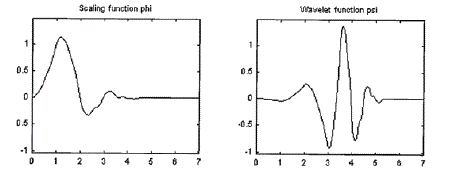 |
| A wavelet image compression system can be created by
selecting a type of wavelet function, quantizer, and
statistical coder. In this paper, we do not intend to give a
technical description of a wavelet image compression
system. We used a few general types of wavelets and
compared the effects of wavelet analysis and
representation, compression ratio, image content, and
resolution to image quality. According to this analysis,
we show that searching for the optimal wavelet needs to
be done taking into account not only objective picture
quality measures, but also subjective measures. We
highlight the performance gain of the DWT over the
DCT. Quantizers for the DCT and wavelet compression
systems should be tailored to the transform structure,
which is quite different for the DCT and the DWT. The
representative quantizer for the DCT is a uniform
quantizer in baseline JPEG, and for the DWT, it is
Shapiro’s zero tree quantizer. Hence, we did not take
into account the influence of the quantizer and entropy
coder, in order to accurately characterize the difference
of compression performance due to the transforms
(wavelet versus DCT)c |
PERFORMANCE ANALYSIS AND RESULTS |
| The results presents in this thesis compare the
image compression performance of periodic and
symmetric extension techniques using the TDM nonexpensive
DWT method. A 5-level DWT
decomposition is followed by SPIHT quantization. Both
objective as well as subjective performance of the
compressed image are evaluated. The objective
performance is measured by peak signal-to-noiseratio
(PSNR) of the reconstructed image ~x. PSNR
measured in decibles (dB) is given by: |
| PSNR = 10 log10 255 MSE !; where the value 255 is
the maximum possible value that can be attained by
the image signal. Mean square error (MSE) is
defined as PSNR is measured in decibles (db). It
has been shown that PSNR is not always a
indicator of the subjective quality of the
reconstructed image [24]. We also evaluate the
subjective performance by visible artifacts in the
reconstructed image. |
CHOICE OF WAVELETS AND IMAGES |
| We employ 7 LA orthogonal daubechies wavelets,
7(A) orthogonal daubechies wavelets and 2
biorthogonal wavelets. It has been shown in chapter
3 that the least asymmetric wavelets and the
corresponding asymmetric wavelets differ only in the
GDD parameter. |
| Hence, by performance comparison of LA and A
wavelets, we illustrate the importance of linear
phase on compression performance. We then chose
the best performing orthogonal wavelets and
compare their compression performance against
similar biorthogonal wavelets when both use
symmetric extension. |
| The compression performance is evaluated for
twelve grayscale images that can be grouped into
three image types: four low frequency (LF) (Lena,
peppers, boat, goldhill), four medium frequency (MF)
(Barbara, lighthouse, Nitf7, House), four high
frequency (HF) (Sattelite, Mandrill, Grass, SanDiego)
images. |
| The frequency type groups are based on the
percentage of total images energy (96% - 100% LF,
92% - 96% MF and 92% HF) in the LL subband
obtained after one level of decomposition using the
wavelet. The distribution of energy for the twelve
image. |
PSNR RESULTS |
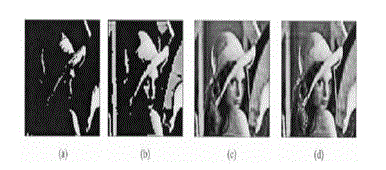 |
| Where L and J are filter length and number of
decompositions respectively. For, simplicity we
consider only composition required for calculating
the wavelet transform. For example, for a 256 * 256
image decomposed J = 5 and L = 10, the
complexity will be approximately 3.5 million
operations (MOP). |
SUBJECTIVE RESULTS FOR SYMMETRIC
EXTENSION |
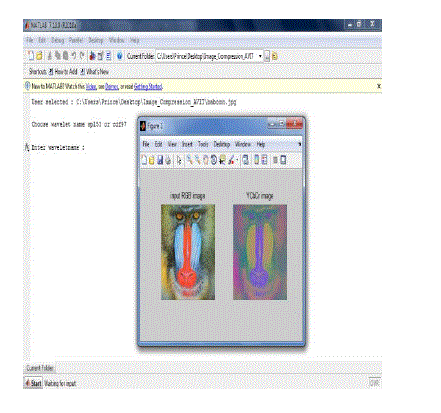 |
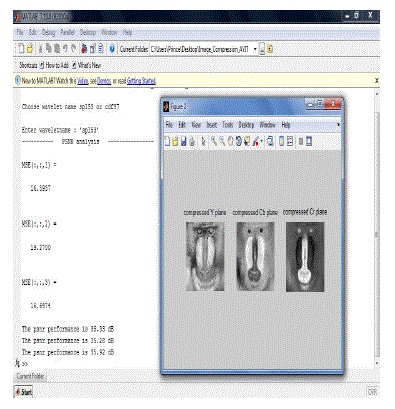 |
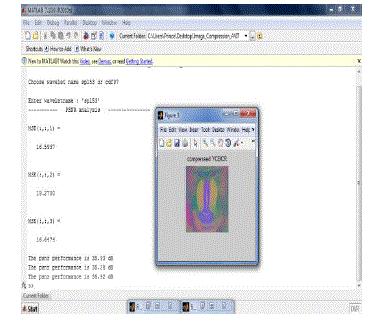 |
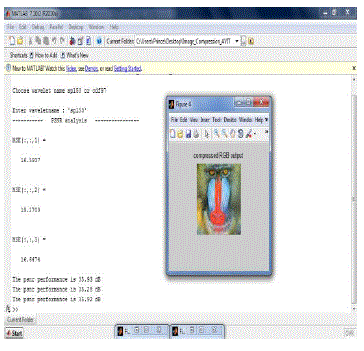 |
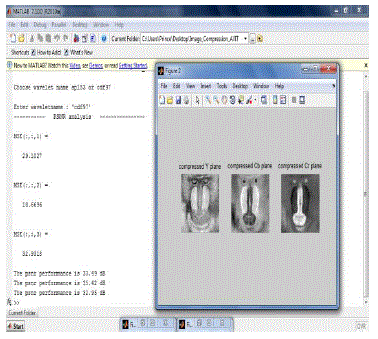 |
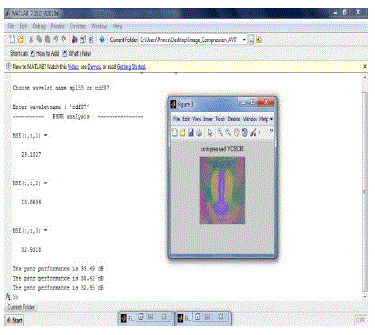 |
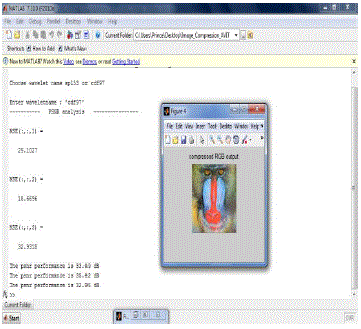 |
ITERATIVE DECOMPOSITION |
| The preceding chapter was concerned with only one
scale decomposition of images. The test images were decomposed into four quadrants where the
optimization of filters and testing took place. Such
one scale iteration is not used for practical image
compression intentions, rather the iteration process
is repeated with decompositions of low – low sub –
images several times. |
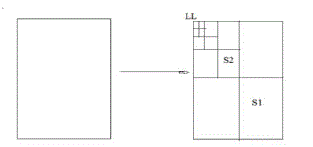 |
| Image decomposition L: f (x, y) R: w(x, y) |
| In this chapter we concentrate on weighted type B
lters, as they gave the most qualified results, and
try to implement a 4 level dyadic iteration of the
low frequency zone; this divides the image into a
total of 13 different subzones. We denote the
LH/HL/HH zones of the rst iteration for s1, the
subbands of the second iteration for s2 and so on
till s4. The LL zone ( include in s4) corresponds to
the small quadrat on upper left. For the 256 * 256
test image low – low subimage consist of 16 * 16
pixels. |
TEST IMAGES |
 |
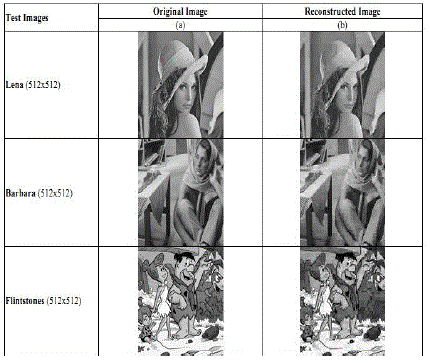 |
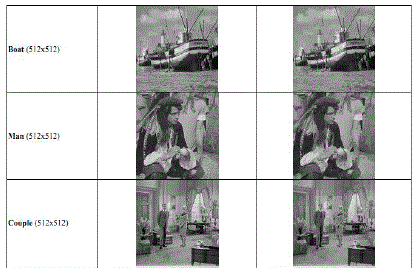 |
EQUAL WEIGHTS |
| Selecting equal weights Q1 = Q2 = Q3 =Q4 is a
straight forward option and table 7.3 shows the
outcomes in this circumstance ; 9 -7 filter with all
the loads at 1000. Equal loads for S1, S2, S3 and
S4 (LL excluded) can easily be seen as not being a
reasonable choice for the optimization as with
iterations the quantity of energy in the subbands
increases, this must be allowed and tolerated by
selecting decreasing loads for the iterative subzones. |
WEIGHTS RELATIVE TO THE AREA |
| A different weight selection for Q1; Q2; Q3 and
Q4 can be related with the number of pixels they
cover . the outer zone S1 covers three quarter of
the image while S2 only one fourth of this, 3 44.
The S3 part 3 444 while S4 (ignoring LL) conceals
3 444 part of the image. The weights can therefore be
multiplied relative to the field. Starting with Q4 = 1000
one obtains Q3 = 250, Q2 = 62:5, and Q1 = 15:6. |
9/7 FILTERS |
| Selecting this optimization method we constructed
optimized 9 – 7 filters for all three test images, the
outcomes from the decompositions are in table 7.4.
the average entropy values are not any better than
under CDF 9 – 7, however, together the total energy
in S1, S2 and S3 compared with the CDF filter is
lower for the optimized filter and likewise is the
situation for the entropy in these zones. The
artificial M3 image though is an exception. Still, one
does not observe any large energy increases for the
S4 zone and the effect of energy shifting seems to
be minimal, on the contrary one notices a power
increases for the S1 area. |
ITERATIVE DECOMPOSITION |
| With Q = 1000 this optimization strategy returns =
0:3214 for M2 and = 0 : 2564 for M3 and 9 – 7
filter pair. The value for M3 is very different from
the others as this pictue is clearly distinctive from
the rest. The emphasis of this chapter has been on
designing optimized seperable filters for images
which would transfer as much energy as possible to
the low – low subimage. We investigated different
models of type a filter and with stability limits one
can quite acceptable filters. |
| For weighted type B filters on the hand other the
stability problem more or less vanishes and filters
can manage to shift considerable energy away from
the high - high frequency zone. For many natural
images this can gives extra gains for lossless
entropy coding. The weights for high frequency
images can also be set up in such a way to
minimize to total energy or the average entropy by
implementing a double optimization. |
| By changing the optimization criteria and selecting
weights relative to the total area covered by a
subbands, optimized filters can be designed with reasonable coding property. Such algorithm can be
used to design filter which can yield slightly higher
PSNR values at the same or lower b = p coding
rates compared with some traditional filters. |
CONCLUSIONS AND FUTURE WORK |
| We have presented the design of a novel class of bi
orthogonal wavelet systems, the GBCW systems, which
possess several remarkable properties. In particular,
three FB’s in this family have been shown to be
competitive with the CDF-9-7 FB in DWT-based image
compression. Furthermore, the multiplication-free
DWT/IDWT using the GBCW systems are promising in
the realization of real-time image and video codec. |
| In this paper, we have proposed a hybrid scheme
combining Kohonen’s Self Organizing Feature Map
(SOFM) based Vector Quantization (VQ) coding and Set
Partitioning In Hierarchical Trees (SPIHT) coding for
effectual compression of images. Initially, the input
image has been subjected to bi orthogonal wavelet
transform. Then, the decomposed image has been
compressed using SPIHT encoding, which outputs a bit
stream. Subsequently, the resulted bit stream is fed to the
SOFM based VQ coding for further compression. The
SOFM algorithm has generated a codebook
corresponding to the inputted bit stream and then based
on the generated codebook has effectively compressed
the bit. |
| A Hybrid Coding Scheme Combining SPIHT and SOFM
Based Vector Quantization for Effectual Image
Compression 438 stream to attain the final encoded data.
The original image has been reconstructed with the
linear combination of its corresponding processes as in
image encoding. The reconstructed image
qualityachieved after decoding has been of desirable
quality. The experimental results have portrayed
theeffectiveness of the proposed hybrid scheme in image
compression. |
| In this paper, we presented results from a comparative
study of different wavelet-based image compression
systems. The effects of different wavelet functions, filter
orders, number of decompositions, image contents, and
compression ratios are examined. The final choice of
optimal wavelet in image compression application
depends on image quality and computational complexity.
We found thatwavelet-based image compression prefers
smooth functions of relatively short length. A suitable number of decompositions should be determined by
means of image quality and less computational
operation. |
| Our results show that the choice of optimal wavelet
depends on the method, which is used for picture quality
evaluation. We used objective and subjective picture
quality measures. The objective measures such as PSNR
and MSE do not correlate well with subjective quality
measures. Therefore, we used PQS as an objective
measure that has good correlation to subjective
measurements. |
| Our results show that different conclusions about an
optimal wavelet can be achieved using PSNR and PQS.
Each compression system should be designed with
respect to the characteristics of the HVS. Therefore, our
choice is based on PQS, which takes into account the
properties of the HVS. We analyzed results for a wide
range of wavelets and found that BW-2.2 provides the
best visual image quality for different image contents.
Additionally, BW-2.2 has very low computational
complexity in comparison with the other wavelets. BW-
2.2 is used in analysis and comparison with DCT.
Although DCT processing speed and compression
capabilities are good, there are noticeable blocking
artifacts at high compression ratios. However, DWT
enables high compression ratios while maintaining good
visual quality. Finally, with the increasing use of
multimedia technologies, image compression requires
higher performance as well as new features that can be
provided using DWT. |
Tables at a glance |
 |
 |
| Table 1 |
Table 2 |
|
References |
- I. Daubechies, Ten Lectures on Wavelets. Philadelphia, PA: SIAM,1992.
- A. Cohen, I. Daubechies, and J. C. Feauveau, “Biorthogonal bases of compactly supported wavelets,” Commun. Pure Appl. Math., vol. 45,pp. 485–560, 1992.
- M. Vetterli and C. Herley, “Wavelets and filter banks: Theory and design,” IEEE Trans. Acoust., Speech, Signal Processing, vol. 40, pp. 2207–2232, Sept. 1992.
- S.-M. Phoong, C. W. Kim, P. P. Vaidyanathan, and R. Ansari, “A new class of two-channel biorthogonal filter banks and wavelet bases,” IEEETrans. Signal Processing, vol. 43, pp. 649–665, Mar. 1995.
- W. Sweldens, “The lifting scheme: A custom-design construction of biorthogonal wavelets,” Appl. Comput. Harmon. Anal., vol. 3, pp. 186–200, 1996.
- Fed. Bureau Invest., “The FBI wavelet/scalar quantization fingerprint image compression standard.”
- J. D. Villasenor, B. Belzer, and J. Liao, “Wavelets filter evaluation for image compression,” IEEE Trans. Image Processing, vol. 4, pp. 1053–1060, Aug. 1995.
- H. Tao and R. J. Moorhead, “Lossless progressive transmission of scientific data using biorthogonal wavelet transform,” in Proc. IEEE Int. Conf. Image Processing, Austin, TX, Nov. 1994, vol. III, pp. 373– 377.
- G. Beylkin, R. Coifman, and V. Rokhlin, “Fast wavelet transforms and numerical algorithms,” Commun. Pure Appl. Math., vol. 44, pp. 141–183, 1991.
- I. Daubechies, “Orthonormal bases of compactly supported wavelets II—Variations on a theme,” SIAM J. Math. Anal., vol. 24, pp. 499–519, Mar. 1993.
|